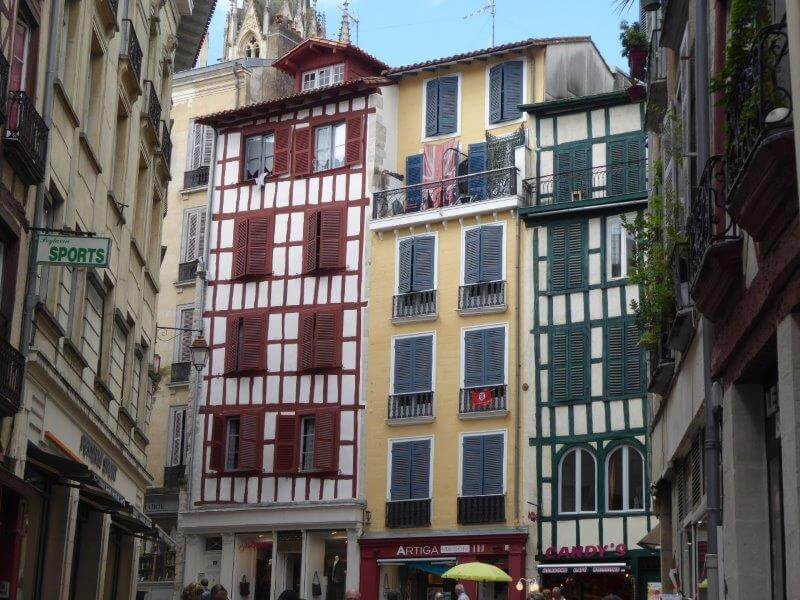What’s your favourite place in France? As a specialist in writing about our nearest Continental neighbour, it’s a question I’m asked a lot but can never answer. For a start, it wouldn’t be fair – France has so many highlights to offer – and secondly, it depends what I want to do. Chill out by the sea or walk in the mountains; soak up some city culture or relax on a river cruise.
But I have to admit to having a soft spot for the far south-west corner of the Hexagon, as the French call their geometrically-shaped homeland. Basque Country boasts a unique combination of coast, countryside and mountains in one neat package, a vibrant and colourful area with a flavour all its own.
Basque Country is a land with no official borders that spans both France and Spain, straddling the Atlantic end of the Pyrenees, and sharing a common language and traditions. Made up of seven provinces – three in France and four larger ones in Spain – it is quite unlike anywhere else in either country. Intrigued? Here are five good reasons why I think you should consider French Basque Country for your next French holiday – Culture, Colour and Coastline, Countryside and Cuisine. Find out more at www.biarritz-pays-basque.com
Culture
The three French provinces together make up the western half of département 64 – Pyrénées-Atlantiques – in the Nouvelle-Aquitaine region. The main coastal towns are the resorts of Biarritz and St-Jean-de-Luz with nearby Bayonne designated official capital of French Basque Country.  People speak French here, but you’ll also find dual-language road signs with names in Euskara, the official Basque language that is increasingly taught here in schools and also spoken on the other side of the Pyrenees. Expect lots of words with ‘x’, ‘z’ and other high-scoring Scrabble letters.
People speak French here, but you’ll also find dual-language road signs with names in Euskara, the official Basque language that is increasingly taught here in schools and also spoken on the other side of the Pyrenees. Expect lots of words with ‘x’, ‘z’ and other high-scoring Scrabble letters.
Visit the Musée Basque in Bayonne to find out about Basque architecture and lifestyle, dances, music and art. And maybe take in a game of pelota, a fast and furious sport that is akin to squash but played in numerous variations against a high wall called a fronton; every village has its own open air fronton, but there are indoor versions of the game too such as cesta punta. Surf culture has been strong here since it was introduced from America in the ‘50s, and not just amongst the young. Meanwhile, Basque Country’s other sporting passion – as in all south-west France – is rugby. You’ll find former French internationals running restaurants in Biarritz and even commemorated on murals.
Colour
East of the invisible Basque Country boundary lies the Béarn, home to Pau and Lourdes. You’ll know when you’ve arrived there because the architecture changes in an instant. Basque Country is characterised by its whitewashed houses with half-timbering in red ‘ox blood’ or sometimes green. Move into Béarn and you’re suddenly amongst stone houses with slate roofs.
Basque flags carry on the red and white theme, and everyone dresses in traditional colours and costumes for the annual summer festival in Bayonne. But Basque Country comes in other vibrant shades too. The deep blue of the Atlantic beaches, the green foothills of the Pyrenees, and the multi-coloured stripes of traditional Basque table linens and espadrilles, not forgetting the spectacular golden sunsets.
Coastline
The Côte Basque stretches from the Nive estuary close to Bayonne in the north to Hendaye on the Spanish border in the south, a mix of family-friendly beaches and rolling surf.  Elegant Biarritz became popular in the 1850s thanks to Napoleon III and his Spanish wife Eugénie, who built their summer palace here, now the Hôtel du Grand Palais, location for the 2019 G7 Summit. Walk the undulating headland promenade; browse the covered market; and don’t miss the excellent aquarium behind an Art Deco façade.
Elegant Biarritz became popular in the 1850s thanks to Napoleon III and his Spanish wife Eugénie, who built their summer palace here, now the Hôtel du Grand Palais, location for the 2019 G7 Summit. Walk the undulating headland promenade; browse the covered market; and don’t miss the excellent aquarium behind an Art Deco façade.
I never tire of Biarritz, the buzz of the restaurants and cafes, the tempting boutiques, and varied coastal views, but nor can I resist the very different feel of St-Jean-de-Luz a little further south. ‘Sun King’ Louis XIV got married here in 1660 – visit the galleried church where he tied the royal knot – but it was Napoleon III who ordered the building of the breakwater which today gives this charming town a safe, sheltered beach for tranquil beach days.
Countryside
 Turn your back on the coast and the hills and valleys of Basque Country are permanently lush, thanks to the proximity of both ocean and mountains. The hills and valleys are splashed with red- and-white communities that include four listed amongst Les Plus Beaux Villages de France – Sare, Ainhoa, La Bastide-Clairance, and St-Jean-Pied-de-Port, the latter also famous as the last French stopover on the Compostela pilgrims’ trail before Spain.
Turn your back on the coast and the hills and valleys of Basque Country are permanently lush, thanks to the proximity of both ocean and mountains. The hills and valleys are splashed with red- and-white communities that include four listed amongst Les Plus Beaux Villages de France – Sare, Ainhoa, La Bastide-Clairance, and St-Jean-Pied-de-Port, the latter also famous as the last French stopover on the Compostela pilgrims’ trail before Spain.
Don’t miss colourful Espelette, centre of the local pimento industry, and the beautiful Villa Arnaga, near Cambo-les-Bains. Built by playwright Edmund Rostand on the proceeds of his play Cyrano de Bergerac, it’s a theatrical treat with a garden to match.
Cuisine
 Basque Country is famous for its charcuterie, not just the famous cured Bayonne Ham but also salami and sausages. Cheese-fan? Most popular varieties here are made from sheep’s milk – Fromage de brebis. Ask at any Tourist Office about visits to producers and local shops, then buy vacuum-packed to bring home. Bayonne is also famous for its handmade chocolate, a skill brought to the city by Jewish settlers escaping the Spanish inquisition.
Basque Country is famous for its charcuterie, not just the famous cured Bayonne Ham but also salami and sausages. Cheese-fan? Most popular varieties here are made from sheep’s milk – Fromage de brebis. Ask at any Tourist Office about visits to producers and local shops, then buy vacuum-packed to bring home. Bayonne is also famous for its handmade chocolate, a skill brought to the city by Jewish settlers escaping the Spanish inquisition.
And for an irresistible sweet treat, have a slice of Gateau Basque with your coffee – a crisp crust with a soft interior flavoured with almond cream, cherry jam, or chocolate. Glass of wine? Try Irouleguy wines from the area around St-Jean-Pied-de-Port – little known outside the area and absolutely delicious. Cheers!
For holidays to France Silver Travel Advisor recommends Simpson Travel – France.











